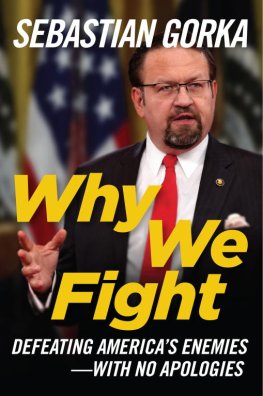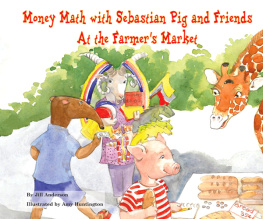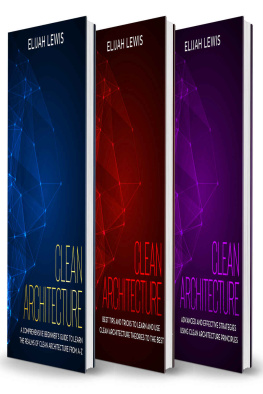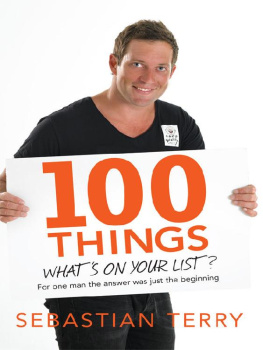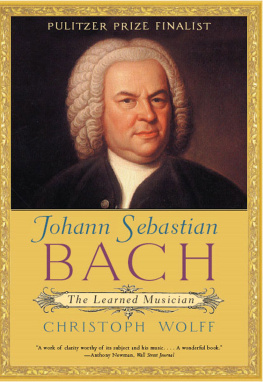Sebastian Buczyński - Implementing The Clean Architecture
Here you can read online Sebastian Buczyński - Implementing The Clean Architecture full text of the book (entire story) in english for free. Download pdf and epub, get meaning, cover and reviews about this ebook. year: 2020, genre: Computer. Description of the work, (preface) as well as reviews are available. Best literature library LitArk.com created for fans of good reading and offers a wide selection of genres:
Romance novel
Science fiction
Adventure
Detective
Science
History
Home and family
Prose
Art
Politics
Computer
Non-fiction
Religion
Business
Children
Humor
Choose a favorite category and find really read worthwhile books. Enjoy immersion in the world of imagination, feel the emotions of the characters or learn something new for yourself, make an fascinating discovery.
- Book:Implementing The Clean Architecture
- Author:
- Genre:
- Year:2020
- Rating:4 / 5
- Favourites:Add to favourites
- Your mark:
- 80
- 1
- 2
- 3
- 4
- 5
Implementing The Clean Architecture: summary, description and annotation
We offer to read an annotation, description, summary or preface (depends on what the author of the book "Implementing The Clean Architecture" wrote himself). If you haven't found the necessary information about the book — write in the comments, we will try to find it.
Implementing The Clean Architecture — read online for free the complete book (whole text) full work
Below is the text of the book, divided by pages. System saving the place of the last page read, allows you to conveniently read the book "Implementing The Clean Architecture" online for free, without having to search again every time where you left off. Put a bookmark, and you can go to the page where you finished reading at any time.
Font size:
Interval:
Bookmark:

This book is meant to be a supplement to Robert C. Martins Clean Architecture: A Craftsmans Guide to Software Structure and Design . It is focused on practical aspects of applying the Clean Architecture in IT projects. I find a scarcity of good - quality implementation examples unsatisfactory. Since I used this approach successfully in a few projects, I believe I have plenty of illuminating insights to share with the community.
At the same time, I came across some limitations which I had to overcome. Sometimes the cure was to use other technique (such as CQRS - Command Query Responsibility Segregation ), sometimes it would be better not to use the Clean Architecture at all.
In short, this book was conceived to share all experience me and my colleagues got during the implementation of the Clean Architecture.
World of Python is a magical, enchanting place. Imagine you are to write some boilerplate code needed to implement an actual feature. Virtually every time you are about to fall under such an evil spell, you can break it by casting a counter-spell:
pip install
Ease of using this command combined with libraries profusion enables everyone, including apprentices of sorcery, to solve seemingly complex problems with a little mana expense. Nowadays, wizardry called software development can be picked up and practised almost effortlessly without knowing its arcana, though nature of the magic itself has not changed at all. This creates an illusion that knowledge about principles and patterns is no longer needed. Although entry point is lowered, deluded sorcery apprentices are far from being enlightened.
Literally every tool python developers use daily is an implementation of long-know (more than decades) and an extensively described pattern of some sort. Django ORM? It is an example of Active Record pattern implementation, widely known thanks to Ruby On Rails which follows the same pattern. For example, it was described in Martin Fowler's Patterns of Enterprise Application Architecture using these words:
"Its easy to build Active Records, and they are easy to understand. Their primary problem is that they work well only if the Active Record objects correspond directly to the database tables: an isomorphic schema. (...) Another argument against Active Record is the fact that it couples the object design to the database design. This makes it more difficult to refactor either design as a project goes forward.
What about something more sophisticated, like SQLAlchemy's session? It turns out the pattern behind it is called Unit of Work and is described in the same book. Suddenly an impression of magic powering PyPi packages fades away to eventually vanish. Such knowledge is an invaluable help to choose the right tools for the job. At the same time, a tool which solves your most acute problem will cause several lesser ones, yet those ones you can live with. For example, SQLAlchemy's session forces a developer to register any newly created model using add method. Without it, no data will be persisted upon commit. Is the necessity for manual models management worth the trouble, or maybe Django ORM is just ok for this particular project?
The most effective cure for indecisiveness is to stay pragmatic and flexible. In fact, this is what this book is truly about. Even though it explains an exciting approach which highlights the importance of business concerns, it does not conveniently omit drawbacks.
Whenever a new project is started, developers should ask themselves: which approach/framework/library should they use? I may ask in return: What problems would you prefer to have? What issues you have to avoid?
This book is aimed at intermediate-/senior-level software developers who wish to broaden their knowledge with various software engineering techniques that emerged over the last several years.
Almost all code examples are written in Python, so the reader's acquaintance with its syntax will be helpful. Luckily, software engineering is mostly technology-agnostic discipline, so even if readers do not write code in Python for a living, they still might use this book to learn something new. All code snippets were written using Python 3.7 and later modernized to Python 3.8.
In theory, theory and practice are the same. In practice, they are not."
This book is mainly to provide tons of practical advice on implementing the Clean Architecture. Everything is based on my experiences, learnt the hard way. Sometimes it was immediately apparent that a certain solution is a bad idea. Sometimes we needed a laborious refactoring weeks later to undo bad design. Few times we have not had an opportunity to improve something that desperately needed it.
With trial and error, we found out how we can evolve our software using more and more sophisticated techniques, like CQRS, Event Sourcing or Domain-Driven Design. The greatest thing was the ability to pick one them up whenever we actually needed them, without investing a lot of time and effort in a big design upfront or having to rewrite everything from scratch.
Implementing the Clean Architecture is a bit like a buffet - a reader is encouraged to get out of it whatever seems to suit best their need and mood. It makes no sense to follow every rule & recommendation rigorously if a simpler approach would suffice.
IT is an industry which changes rapidly all the time. New languages and frameworks emerge daily, just to be forgotten several years later. Solutions that once were popular become an enormous technical debt soon after the last contributor abandoned the project. On the other hand, there are few successful, long-living projects which are continuously maintained and developed. Although we get new features and security updates regularly, it still requires some effort to keep up with the newest versions of your favourite web framework.
The only thing that is constant is change - Heraclitus
This task becomes cumbersome if the business logic of a project is tightly coupled to a framework. Every backwards-incompatible update in the framework's codebase breaks something in the actual application. Such a situation is inconvenient for both maintainers and users of the framework. The former group is under constant pressure not to break anything with a new release. Just imagine how discouraging the situation is.
Some applications are pretty straightforward. All they need to do is just fetch some data from a database, modify it and save back. A common name for a database browser is CRUD ( Create Read Update Delete) . Adding REST API increases complexity only a bit. Using Django for such a project is one of the best choices one may make in the Python world.
The situation becomes a lot trickier when we deal with more complex domains. They are actually pretty easy to recognize. One of the symptoms might be a vast number of checks to conduct. Invariants spanning multiple objects are even more interesting. Say, we are to build a new project where people can bid on auctions. An auction can have 0, 1 or multiple winners at the same time. An auction has an end time after which no one can bid.
If we were to use CRUD approach a'la Django/RoR, then most likely we would end up with separate models for Auction and Bid :
class Auction (models . Model):
title = models . CharField(max_length = )
starting_price = MoneyField(
Font size:
Interval:
Bookmark:
Similar books «Implementing The Clean Architecture»
Look at similar books to Implementing The Clean Architecture. We have selected literature similar in name and meaning in the hope of providing readers with more options to find new, interesting, not yet read works.
Discussion, reviews of the book Implementing The Clean Architecture and just readers' own opinions. Leave your comments, write what you think about the work, its meaning or the main characters. Specify what exactly you liked and what you didn't like, and why you think so.


